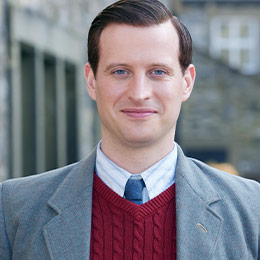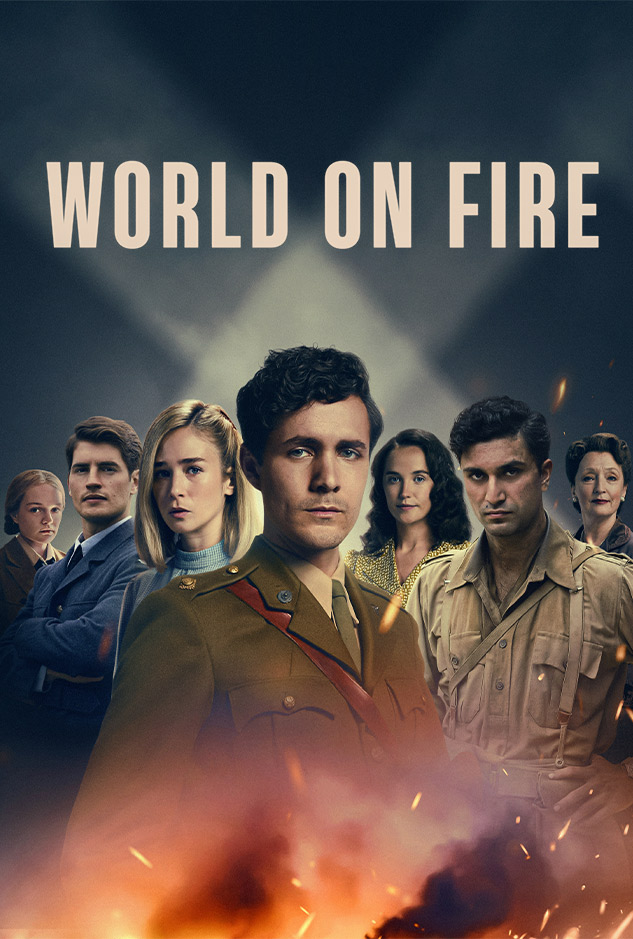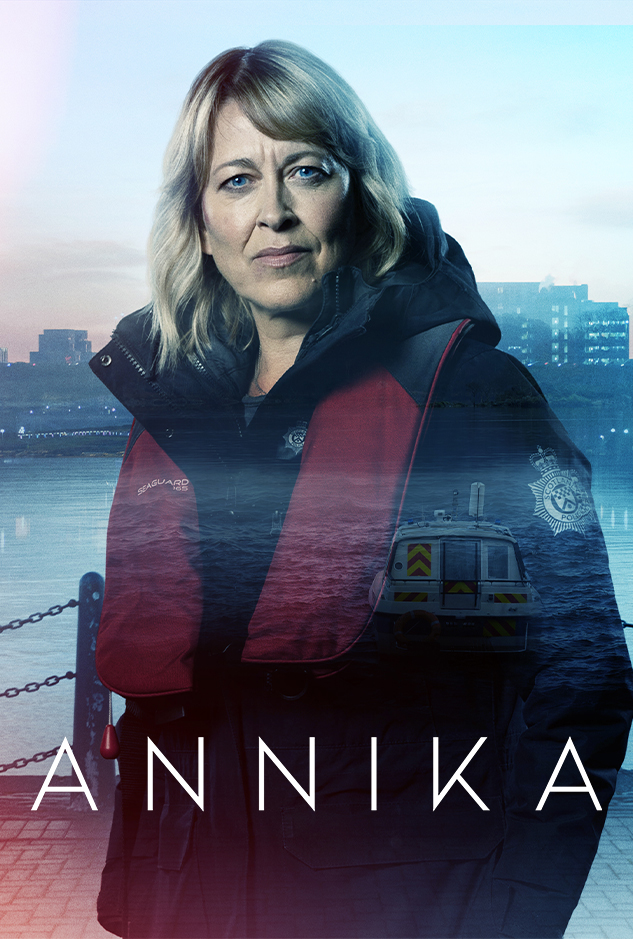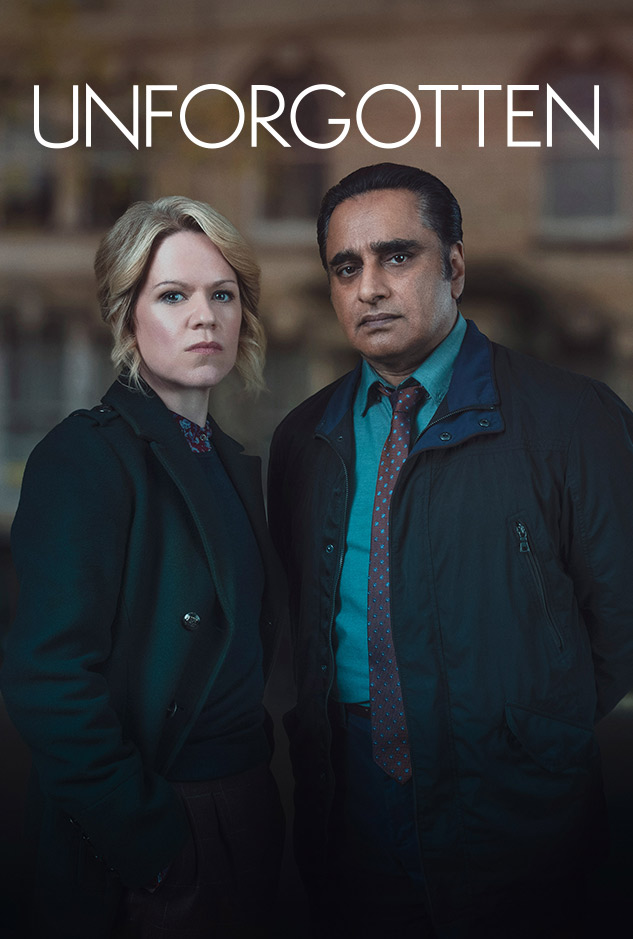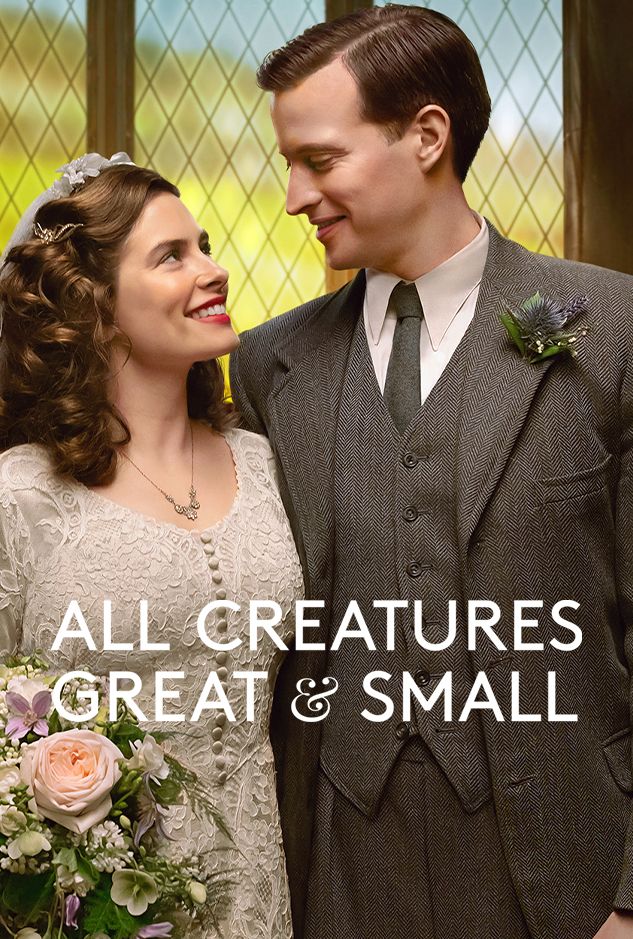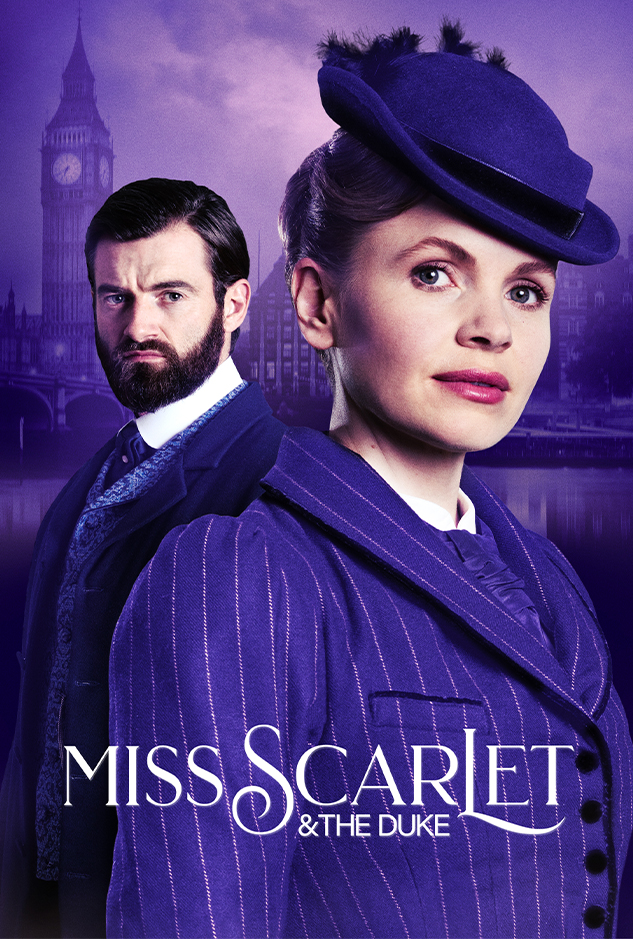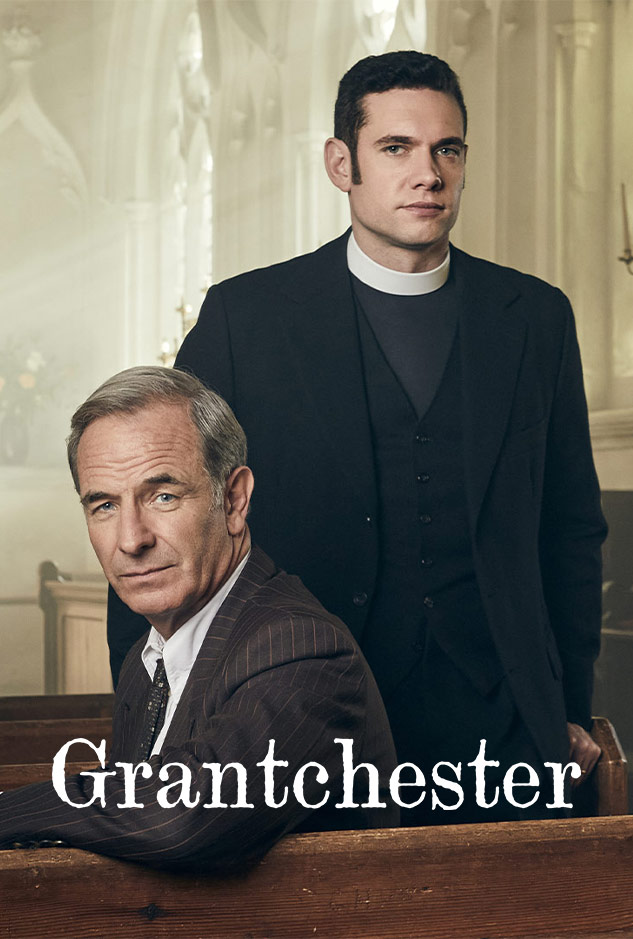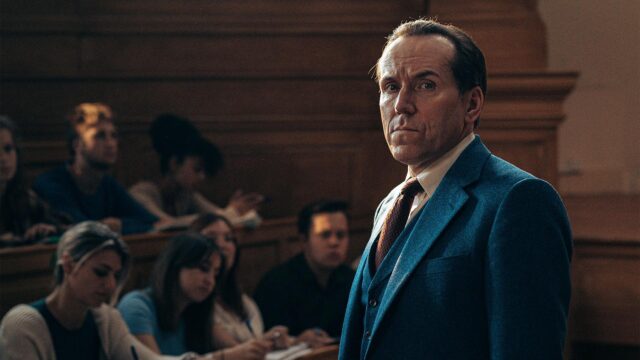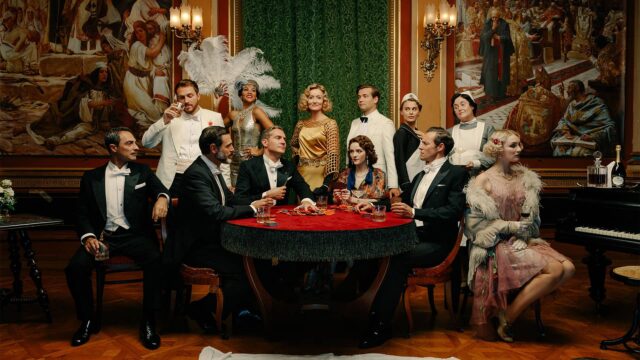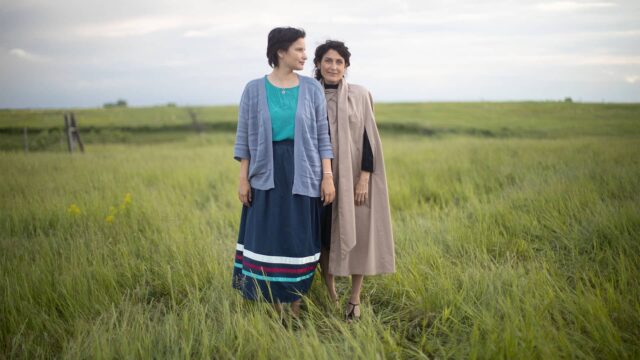Training All Horses Great and Small: Behind the Scenes
How does All Creatures Great and Small achieve such brilliant performances from its animals? Go behind the scenes with trainer Ben Atkinson of Atkinson Action Horses to learn all about Mojo, the magnificent horse who stars as River in Season 3 Episode 3. He reveals how they work with the horses to create those powerful emotions on screen, plus much more about Mojo (who also acted in Poldark and Victoria), hardworking horseman Samuel West, and the identical twins who stood in for Siegfried’s stunts!
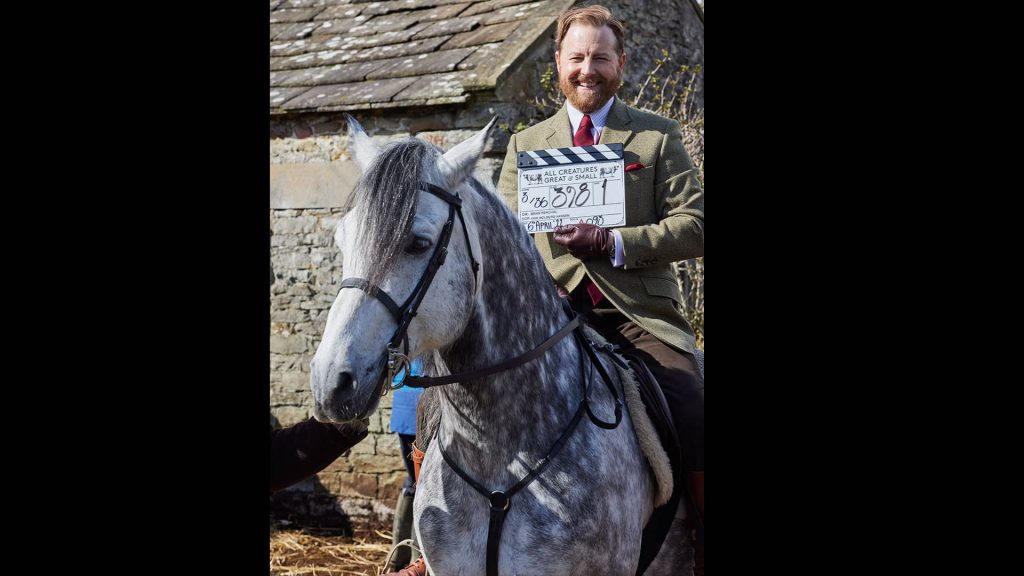

What can you tell us about Mojo, the wonderful horse playing River?
Mojo is a native English breed, Welsh Section D, and he is a fantastic horse. He’s around nine, ten years old now, and I’ve had him since he was about four years old, since he started his working life. I’ve performed with him all over the UK—I’ve been out to Europe with him, and we were in Denmark in the start of the year performing out there. And so he’s an old hand.
One thing we try and do for all of our horses is keep their life as varied as possible, because we know as humans, we like to keep life varied, and so we keep fresh and alert. It also helps their bodies last for longer. So Mojo is a fantastic horse for riding. He’s a good jumping horse. He also does the liberty work, like we saw in All Creatures, with working loose, and he works in a carriage and other stuff as well. He’s been doing it for a long time, but one thing that makes Mojo absolutely brilliant is that he’s such a calm horse, naturally, even from being a baby.
How did you come to cast Mojo in the role of River?
One thing that’s lovely about All Creatures is it’s a job where it’s so much fun that all the same crew and people have been on every season—everyone always wants to come back. The feeling you get when you watch it is the feeling you get when you make it. And so when we got the script, they said, we’ve written it so one horse is in the flashbacks in the first World War and then the other horse is in the modern day, and it’s a racehorse storyline. And so I said, okay, we do keep a few thoroughbreds and racehorses. But they said the condition, the major condition in this is that as long as it’s not a stunt. There are a couple of stunt falls—of course we use stuntmen there because we’re not going to jeopardize actors—but Samuel West, who plays Siegfried and who interacts with the horse, took out of his own free time—I mean hours, weeks, combined days into weeks, nearly every weekend, midweek, he would come up to ours [East Yorkshire] from London so that he could spend time with the horses and be trained to get ready for this exceptional episode.


So Sam actually did pretty much everything, bar two shots: one of them is the stuntman falling off and one was a scene working with a drone without a saddle, up and down hills, so we were just like, “We can’t let you do that.” But everything you see where he’s working with the horse when it’s loose, when the horse is rearing, when he’s riding Pegasus with River alongside at liberty, that’s all him. There are no secret wires, there are none of us green screened out. He trained and learned how to do it, which was phenomenal.
When they gave us the script and they said that Sam was going to do it all, we did have to choose [the right] horse. The casting director was very open-minded when Mojo got the role—he’s perhaps slightly on the wrong bloodlines for the type of horse that he suggested, but he was just absolutely impeccable in terms of the action that we needed to do. And I honestly can’t think of another horse in our team or in anyone else’s that could have achieved the beauty that we did for All Creatures in that storyline using the actor. We’re willing to train the horses—that’s all I do, day in and day out, I adore it—and having an actor that’s willing to put the time in means that you can really make something magical. Because they’re not pretending to love the horse, but then actually can’t wait to get back for a coffee as soon as someone says “cut.” Sam would really do it. In between takes he would stand with the horses, and he was always such a humble man as well, asking us, “Was that correct? Would I touch the horse? Is this the…” Making sure that everything really got across—the emotion and the love that we have for our horses and that so many people that love their animals have was reflected in him as Siegfried when working with River.
When you say “liberty work,” what does that mean?
Liberty work is liberty—it’s to work in freedom, so the idea of a horse that works at liberty is a horse that works without any form of restraint at all. That’s no halter, no ropes, no saddle, no bridle—as naked as the day they were born, in their birthday suit. And so liberty training is something that is based around communication through body language and through the horse looking to be given directions from the trainer while the trainer is equally looking at the horse to read their emotions and the situation.
So there are two types of leaders in a herd. One is a stallion, who comes in and says, “I’m the boss. Anybody who tries to get over me, I’m going to stomp on you.” That can work to being a leader, but no one really likes a boss like that, and the problem is if a scarier stallion comes along, that one will run away and he gives the job up. Now in our world, it doesn’t have to be a stallion because perhaps if a horse—and this is not the way we train—but say if we try to train like that and then we take the horse on set and there’s the lighting rigs and the SFX, the horse is going to say, “Well this is scarier than you are, so I’m out.” That’s the type of training that we stay away from. We try and be the leader, like the lead mare.
Horses are actually a matriarchal society, and they will choose their lead mare because she makes the best decisions. When it rains, she takes them to shelter. When it’s dry, she knows where the watering hole is. She’s elected for her longstanding good decisions that she’s made to be the leader of them. And that’s how we try and get the horses to see us in liberty. It’s not about dominance or being in charge—it’s about proving to this horse, when things get difficult, I will make a choice that makes you feel safe and happy.
That’s just like what Siegfried is doing too, right?
Yeah, exactly. And we worked with the script writers and such along with this to make sure that it was in there. People have played with things like this before, we’ve all seen films like The Horse Whisperer and Black Beauty and we love the magic, but it’s never really explained to us—we just have to go with it, and because we want to, we do. But in this, it’s beautiful like those others and completely true and completely real and realistically achievable. The journey we go on with Siegfried and the horses that he encounters within this storyline is very real, and I think that makes it even more poignant.
In Episode 3, we see River looking terrified and panicked. Can you shed light on the work that you do to elicit the behaviors that we see on screen, and what they mean?
Never work with children or animals, that’s what everyone always says, don’t they? Because here’s a prime example: In a film we did earlier this year, we had a horse that had to [act as though it had been] killed, and when it was laid on the floor, the director said, “Can’t you get it to shut its eyes?” I was like, “Can’t really. Can you get your dog to shut its eyes?” What we have to try and do is not only train movement, but emotion. So we have little signals that are off camera or little sequences that we do with the horse before the shot starts. For example, when Mojo needed to look relaxed, he had a routine that meant he knew that he was going to be standing and he was going to be relaxing, and so his bottom lip would go, his eyes would droop, his ears relaxed. And so we get the correct emotion from the horse within the scene.


Then when we have the scenes where he’s meant to be aggravated, when he’s upset by the groom with the whip. And for those situations, we didn’t just teach him to rear—which is where he stands on his back legs—we trained him to attack a whip. I would hold a whip, and I taught him that when I waved the whip on the floor, he’d stomp on it. And then we praised him more and more until he knew he was going to rear and stomp on it. And then that’s how we got the emotion within the scene. When he’s rearing, his ears come back and he looks angry and frustrated, but it’s actually all manufactured, because what Mojo’s thinking is, I’m killing this stick, but to the audience it gives us the emotion that we want. And that’s the most important thing: When a horse looks scared or uncomfortable or angry on a film, the most important thing for all of us, especially for me, is that that horse doesn’t feel any of those emotions at all. And so it’s training them in such a manner that we can get the look that we want, but in a way that the horse is actually having the best time of its life.
So we, the audience, are anthropomorphizing these behaviors, in a way?
Yeah. I remember in Season 1 [Episode 3], there was the scene when the black racehorse [Andante] had to be put to sleep. In reality, if a horse had the disease that he had, it would simply lay on the floor groaning and sweating, because it’d just be in agony, whereas to a person who knows less about horses than I do about anything else that isn’t a horse, then we need to make it very clear, especially when it’s one storyline among many. So we need to go, “Okay, we need a visual that this horse is unhappy right now. He can walk…what would a human do?” So you’re walking around, we teach them to kick their stomach, like you would be grabbing your stomach…We’re trying to think, like you say, where can we anthropomorphize him and help everybody get the emotion that we need from them in this scene as quickly as possible.
In a scene like the one where Siegfried is thrown from River, what are we not seeing? What’s going on?
Say you’ve got your dog—you could stand in front of your dog and say “sit” or “lay down,” but what if you stood someone in front of you, and you stood behind that person and told the dog to sit? And now, stand the dog, then the actor, then behind them, the cameraman, the focus puller, the sound man, the guy holding the balance board for the lighting—behind all of them is me. The horse has to learn to pick out my voice and my signals, which is one of the reasons we use the big, long whips, so that I can make a signal that goes higher than the people in front of me. Also, the reason we have them so they flick is so that they can make sounds. When you flick the stick and it goes like swish swish, that swish is a signal in itself. That sound is a signal. And so teaching the horses to work at a distance is difficult.


What’s also fun is that the horses learn the routine. Say in that scene where the horse rears and Siegfried falls, we do one rehearsal where I would just ask the horse to rear, and then I’d stand with the first person in front and we’d do it again, and the next person, then the next person, so by the time we get to roll camera, the horse knows the job. Then after you’ve done maybe one take, two takes, by the time they say, “Standby, rolling,” the horse is like, “I’m going. I know the job.”
You don’t always train the horses to do something specifically. For kicking the door, you maybe wouldn’t train a horse specifically to kick that door, but you try to prepare for what might happen on set. You teach a horse to strike out with a front leg, and then to be able to point at different things that they’ll hit, or teach them to turn their heads to the left or to the right or to look up or to look down, take a step forward, take a step backwards. So that we can get those emotions. Sometimes we have to change something because it’s not working for the director, it’s not working for the actor, the sun’s disappeared, we can’t film in that same location. So it is important for the horses not to just be one trick ponies, if you’ll excuse the pun. Because as well, I think it’s important to remember that the animals aren’t the only ones on set, and of course, they get priority because they’ve not chosen to be there.
What’s the process like for filming such an intense episode?
Oh, it takes time. The first stage is that we get the script and we have a read through and then I’ll have a Zoom meeting with myself, my father [Mark Atkinson], who owns the company, and with the director and sometimes with the actors and such as well. Then we’ll all talk it through, because there are some things where we might say, “People are going to write letters if you say this. That wouldn’t happen, but this would.” So the first stage is technical in terms of making sure that we dot the is and cross the ts and it’s all as it would be in the real world.
Then, I go away and play with the horse training, and we shoot previz [previsualizations] on an iPhone that the director and I would send to each other and I’d say, “How about this for this?” And we try and film those at the same angles as we would film on the day, to show how it would look on camera. Then the next step is having the actor, in this case Samuel West, with us, and adding him to the shot, and seeing where Sam can give a subtle cue to the horse so he can do it so we can shoot a wider lens and that sort of thing, and where we’re going to need to have me positioned behind him at certain points. And then discovering the boundaries of where the horse and the actor are comfortable working with one another.


And then there are the little things as well, things that I don’t think everyone would always think about. What gloves is he wearing? Could still manage the reins and the horses or the intricate details that we’ve come up with if he’s wearing those gloves? What boots is he wearing? What trousers is he wearing? Can he get on and off with that? So then we start to work within the costume and makeup department to let them know about what’s going to happen there. Does this horse like to nudge people? Well, maybe want to put another pin in that wig to make sure it stays in the place it is. It’s a really huge process. But on All Creatures, where everyone’s so close and so friendly, it’s a little bit like having lots of Zoom calls with your family and drinking tea.
Has it been the same stunt person playing Siegfried across the seasons?
Yeah. Well, I’m going to say it’s the same stuntman, but the problem is they’re identical twin brothers, Rob and James Pavey. So if you have a very busy day, you can get two for the price of one that look identical. And the brilliant thing about the Pavey brothers is that they are stuntmen, obviously—they’re on the Stunt Register—but they’re also equine dentists. They were equine horse dentists and performed as stuntmen and acrobats on horses, doing Cossack style and such when they were younger, and doing jousting, like you see in A Knight’s Tale and that sort of thing in life performances, like you see at [a Renaissance Faire]. They’re brilliant.
![]()
![]()
We like working with stuntmen who work in live performance because if you only work on film, you can always go again, whereas if you choose stunt performers who have worked within live theater, they know, you get it right and you get it right now. And that makes the life easier for the horses on set as well, because one thing we always try and keep in mind is that we know why we’re there, and the horses don’t. One joke we had was about the horse, Sebastian, who played the wounded horse within the shell, the crater in the beginning of the episode, he was so fantastic—again, he’s traveled all over, I’ve performed in Dubai with him and all sorts—and he was such a star with the actors in that shell hole, with the gas coming in and explosions going off. So at the end of the day I was talking to the director and he was like, “Yeah, the horses were good.” I said, “Yeah, especially when they don’t know it’s not real!” When they’re laid in a shell crater full of people screaming and the fake smoke’s coming in and there’s explosions coming up all around and you can hear the gun fire and everyone’s panicked and the actor’s obviously doing a brilliant job, and the horses remain trusting and calm with the people even though they’ve no idea that what’s happening is a game. It’s fantastic.
What motivates the horses? My dog is really food motivated and I know that dogs like to work, but presumably horses are more complex…
I wouldn’t say more complex, but you’ve got predator and prey. So my chihuahua will do nothing if there’s no food because she thinks, why would I hunt if there’s no food? What horses are looking for is that they just want everything to be simple and to know what’s going on. If they know what’s going on and they feel safe and understood, that’s all they want. Because as a prey animal, you just want to have the most peaceful life possible and not get eaten.
We do give treats as treats. I mean, you’re on a film set, there’s a tea table with a lot of biscuits, of course they get their fair share. But one thing we try not to use too many food-oriented treats on set because, in the same way my dog knows that when I open a certain cupboard, that’s where the treats are, horses learn. If you give them tidbits out of your pocket, they start searching everybody’s pockets thinking, “Where’s the food?” And that doesn’t always look great in the scene. So we try not to overdo it with that.
But yeah, I have a basis for training of the four Cs, which are Clarity, Consistency, Confidence, and Calm. So with clarity, you must be clear in your goal and how you ask for it. Consistency is asking for the same movement or behavior in the same way every time. And then if you clearly ask in the same way every time, then the horse grows more confident in offering you that movement or behavior, and can remain calm throughout the entire process.
It seems like your ethos is really clear, and one that the show shares seems to share, as well.
Yeah, hugely. I don’t think anyone would last long on the crew or cast of All Creatures if they weren’t actually an animal lover. Because how could you? And it’s wonderful for us, you are just immersed in it because obviously now, three seasons in, the actors, the crew, everyone’s used to it and you’re working with the same farmers on the same farms and all that sort of thing, and such a wide variety of animals. And I think that’s something that’s fun for all of us. I might know a lot about horses, but it’s fun when I getting to work with the other animal suppliers, with Clive the big bull, who is amazing.
And yeah, I think kindness breeds kind people and I think that’s something that definitely is present within our family, in our team with the horses, and it’s wonderful to find that reflected in the rest of the people there.








